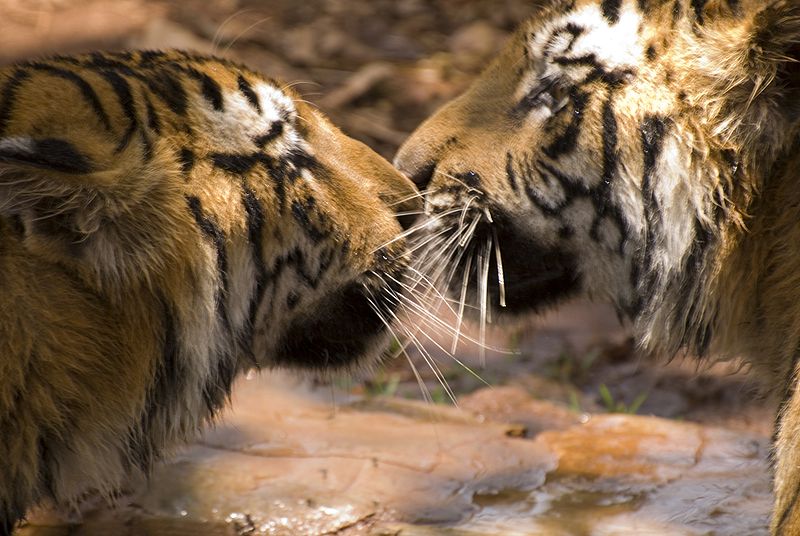|
Tami Nadu - Wildlife of Tamil Nadu - Bengal tiger of Tamilnadu
Biology and Behaviour tiger of Tamilnadu
Previously it was considered the second largest subspecies, behind the Siberian tiger however a recent study suggests that maybe this subspecies could be, on average, the largest of the tigers. The total length for the males is of 270-310 cm meanwhile those of the females is of 240–265 cm;[6] the tail measures 85–110 cm long and the height at the shoulder is 90–110 cm. The average weight is 221.2 kg (487.7 lb.) for the males and 139.7 kg (308 lb.) for the females, however those who inhabit the north of India and Nepal have an average weight of 235 kg (518 lb.) for the males and 140 kg (308.6 lb.) for the females. Its coat is yellow to light orange, and the stripes range from dark brown to black; the belly is white, and the tail is white with black rings. A mutation of the Bengal subspecies, the white tiger have dark brown or reddish brown stripes on a white background color, and some are entirely white. Black tigers have tawny, yellow or white stripes on a black background color. The pelage of a black tiger, recovered from smugglers, measured 259 cm and was displayed at the National Museum of Natural History, New Delhi. The existence of black tigers without stripes has been reported but not substantiated.
The Bengal tiger's roar can be heard for up to three kilometers (almost two miles) away. |
 |
Tiger records
Officially, the heaviest Bengal tiger with confirmed weight was a male of 258.6 kg (570 lbs) and was shot in Northern India in 1938, ] however, the heaviest male captured by a scientist at this time is a male of more than 270 kg (600 lb), tagged in Nepal in 1984. The largest known Bengal tiger, measured between pegs, was a male with a head and body length of 221 cm, 150 cm of chest girth, a shoulder height of 109 cm and a tail of just 81 cm, perhaps bitten off by a rival male. This specimen could not be weighed, but it was calculated to weigh no less than 270 kg. Finally, according to the Guinness Book of Records, the heaviest tiger known was a huge male hunted in 1967, it measured 322 cm in total length between pegs (338 cm over curves) and weighed 388.7 kg (857 lb.). This specimen was hunted in the north of India by David Hasinger and is actually on exhibition in the Smithsonian Institution, in the Mammals Hall.
In the beginning of the 20 century, there were reports of big males measuring about 366 cm (12 ft) in total length, however there was not scientific corroboration in the field and it is probable that this measurement was taken over the curves of the body.
Behaviour
Tigers do not live in prides as lions do. They do not live as family units because the male plays no part in raising his offspring . Tigers mark their territory by spraying urine on a branch or leaves or bark of a tree which leaves a particular scent behind. Tigers also spray urine to attract the opposite sex. When an outside individual comes into contact with the scent, it learns that the territory is occupied by another tiger. Hence, every tiger lives independently in their own territory.
Male Bengal tigers fiercely defend their territory from other tigers, often engaging in serious fighting. Female tigers are less territorial, occasionally a female will share her territory with other females. If a male happens to enter a female's territory, he would probably mate with her, if she is not already pregnant or has a litter. If she is pregnant or has a litter, he has no choice but to find himself a new territory and a mate. Similarly, females entering a male's territory are known to mate with him. Both males and females become independent of their mother around 18 months old, whereupon the cubs have to establish their own territories and fend for themselves. A male territory is larger than a female territory. Bengal tigers kill large animals like brown bears in their territory for food and as a symbol of their power.
Population and distribution of Tigers
The current population of wild Bengal tigers in the Indian subcontinent is estimated to be between 1,300 and 1,500. Of these, 1,411 are found in the wild in India while about 280 are found in Bangladesh, mostly in the Sunderbans. Over the past century tiger numbers have fallen dramatically. Of eight sub-species alive in 1900, three are now extinct and we have lost over 90 per cent of wild tigers.
Habitat losses and the extremely large-scale incidences of poaching are serious threats to species survival. Poachers kill tigers not only for their pelts, but also for body parts used to make various traditional East Asian medicines. Other factors contributing to their loss are urbanization and revenge killing. Farmers blame tigers for killing cattle and shoot them. Poachers also kill tigers for their bones and teeth to make medicines that are alleged to impart the tiger's strength to the human who consumes the medicine. The hunting for Chinese medicine and fur is the biggest cause of the decline of the tigers.
|
